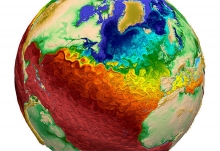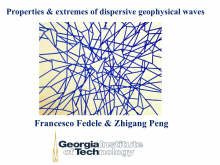An interdisciplinary project to explore the physical, chemical and biological factors that promote the growth of Sargassum blooms in the Tropical Atlantic and investigate the factors that may have changed in recent years (last decade). A novel combination of ecological approaches, remote sensing products, physical modeling, and oceanographic work at sea will be used to investigate and resolve the mechanisms that drive the onset of Sargassum blooms in the Central Tropical Atlantic and their growth and development in waters of the Western Tropical North Atlantic.
When icebergs fracture from ice sheets they often become trapped in a dense icy aggregation called mélange that fringes the coastlines of Greenland and parts of Antarctica. This melange controls the annual cycle of ice sheet mass loss through iceberg fracture at many glaciers and also the rate at which icebergs enter into the open ocean. Once in the open ocean, icebergs can influence ocean circulation through the input of fresh meltwater and may also cause hazardous conditions in Arctic shipping lanes.
Ice sheets have gone through periods of rapid melting, causing sea level to rise many times faster than the current rate of rise. Some of these rapid melting events have occurred during periods when ocean and atmospheric temperatures were at or just above modern temperatures. It is thought that there are instabilities intrinsic in the dynamics of ice sheet flow and melting that may cause such rapid sea level rise events, even without changing climate.
Deep subsurface methane hydrate-bearing sediments contain microbial communities that are distinct from shallow marine sediments and hydrate-free environments. DNA evidence suggests that novel bacterial phyla (e.g. Atribacteria) are highly enriched in methane hydrate-bearing sediments. Recent genome assemblies by the Glass group at Georgia Tech are providing insights into the metabolic potential of samples drilled from gas hydrate stability zone 70 mbsf below Hydrate Ridge (IODP Leg 204).
Geochemical time series from remote Pacific atolls have provided long records of climate variability that extend into the pre-industrial era. Recent studies document a wide range of geochemical variability in corals growing on the same reef, ostensibly of the same genus. Deciphering which fraction of coral geochemistry variations are driven by changes in physical environment versus physiological differences between corals is key to constructing more robust records of past climate variability.
The project aims at further testing a new approach, the maximum entropy production (MEP) model of surface heat fluxes (Wang et al, 2014), for modeling and monitoring air-sea exchange of water and heat air-sea water and heat.
Nonlinear dispersive wave groups or packets occur in a wide range of natural systems, exhibiting complex behaviors especially in focal zones where there is rapid wave energy concentration and possible wave breaking. In the presence of dispersion, pure plane waves of different wavelengths and directions traveling within a medium have different propagation velocities. Important classes of geophysical wave systems include surface gravity waves, oceanic and atmospheric internal waves, and seismic waves.
The recently completed resource assessment for ocean current energy (Haas et al. 2013) utilized fairly simplistic analytical methods to estimate the extractable energy from the Gulf Stream System as well as to analyze the relative impacts of large scale energy extraction. This level of analysis can be considered to be accurate to an order of magnitude and only provides an idea on the overall trends of the impacts of extraction. Much higher resolution modeling is required to accurately determine the overall impacts of extraction for both localized and far field effects.
The student will work jointly between the labs of Drs. Frank Stewart (Biological Sciences) and Kostas Konstantinidis (Biological Sciences, Civil and Environmental Engineering) to characterize a globally important marine bacterial group (SAR11). A collaboration between these labs recently described how SAR11, the world’s most abundant organismal group, has adapted to the unique chemical and physical environment of anoxic oxygen minimum zones (OMZs). This work (Tsementzi et al.











